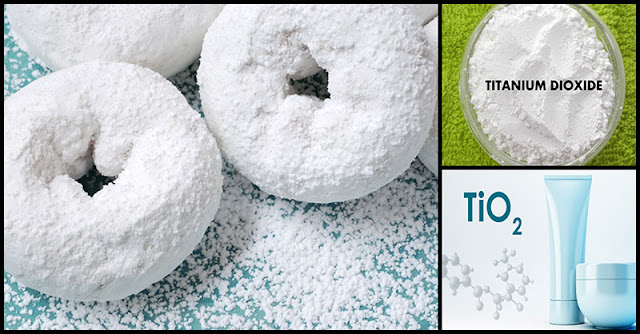Each year, millions of tons of titanium dioxide are produced globally. It is used as a pigment in paints, added to toothpaste, paper, cosmetics, pharmaceuticals, and food.
Titanium dioxide has been used as an ingredient in sunscreens as it reflects ultraviolet (UV) light. It also adds brightness as well as whiteness to products and helps them resists discoloration.
Generally, titanium dioxide is considered to be a safe material. However, lots of products at present are using titanium dioxide nanoparticles, and this may change everything.
Being ultramicroscopic in size, nanoparticles are able to penetrate your skin and travel to your blood vessels and bloodstream. According to studies, some nanoparticles may be carcinogenic and may have toxic effects on your brain and cause nerve damage.
Is Titanium Dioxide In Foods Dangerous?
Highest levels of titanium dioxide have been found in sweets, chewing gum, and candies. Some other products that may contain titanium dioxide are mayonnaise, yogurt and other dairy products, white powdered doughnuts, white icing and even bread.
According to a study, children receive the highest exposure level to titanium dioxide as it is commonly added to sweets and only a limited number of the products have included titanium dioxide on the label.
A research published in the Environmental science and Technology found that nearly 90 food products have up to 36% titanium dioxide nanoparticles variety.
In an animal study published in Cancer Research, titanium dioxide nanoparticles were found to induce oxidative DNA damage, inflammation, clastogenicity (causing breaks in chromosomes), and genotoxicity.
Researchers suggested that they may be a cause of cancer or genetic disorders and concluded that:
“These results have been observed after only 5 days of treatment via drinking water, and in multiple organs suggesting a systemic effect. We also showed that in utero exposure to TiO2 NPs [titanium dioxide nanoparticles] results in an increased frequency in DNA deletions in the fetus.”
“These data suggest that we should be concerned about a potential risk of cancer or genetic disorders especially for people occupationally exposed to high concentrations of TiO2 NPs. It might be prudent to limit ingestion of TiO2 NPs through nonessential drug additives, food colors etc.”
Your Brain Maybe Harmed By Titanium Dioxide Nanoparticles
Titanium dioxide nanoparticles are the second most produced engineered nanomaterial in the world. People have been repeatedly exposed to it before they know the consequence. Titanium dioxide nanoparticles can move from your gastrointestinal tract or lungs to other organs.
Various animal studies have shown that nanoparticles accumulate in the brain and can have negative effects on the brain cell viability and function. Aside from these, it can also induce a decrease in mitochondrial membrane potential, suggesting mitochondrial damage and an increase in reactive oxygen species generation.
Researchers believed that exposure to these particles may cause neurological dysfunction as it can harm astrocyte cells, which help regulate dopamine, serotonin, and other neurotransmitters. It also harms the cells’ mitochondria, which may ultimately lead to cell death.
Two-thirds of such brain cells can be killed within one day due to high levels of exposure (100 parts per million) to these particles.
Oxidative Stress And Mitochondrial Damage
Moreover, studies revealed that those astrocyte cells which were not killed were left damage and failed to absorb the neurotransmitter known as glutamate, which just accumulated outside the cell, thereby may be implicated in Alzheimer’s and Parkinson’s diseases.
Other researches suggest that titanium dioxide nanoparticles may have hidden brain risks. It was found that:
- Titanium dioxide nanoparticles (TiO2 NPs) induce strong oxidative stress and mitochondrial damage in glial cells in your brain.
- Exposure to titanium dioxide nanoparticles may modify oxidative and inflammatory responses as well as the renin-angiotensin system in the brain (which plays a role in cardiovascular health), thus modulating brain function.
- Prenatal exposure to titanium dioxide nanoparticles may result in a change to the olfactory bulb, cerebral cortex, and brain regions intimately related to dopamine systems of offspring mice.
Titanium Dioxide Nanoparticles In Personal Care Products
Personal care products were found to contain titanium dioxide. These include sunscreens, toothpaste, deodorants, shampoos, and shaving creams.
Some studies suggest that it does not penetrate the human skin, even in nanoparticle form. However, there was this one study which has found that the nanoparticles could possibly penetrate the outer layer of skin depending on the particle coating and skin (with or without hair).
It was reported in Environmental Science and Toxicology that:
“The only FDA-stipulated limitation for sunscreens is that the TiO2 concentration be less than 25%. Most have a lower concentration, between 2% and 15%. With the wide prevalence of sunscreen use and the lack of a distinction between TiO2 nanomaterials and larger-sized particles, the general public is being exposed to nanomaterials of which they are largely ignorant.”
Other Unknown Environmental Risks
So what happens when all the nanoparticles in personal care products are flushed down the toilet and washed down the drain?
The author of the study named Paul Westerhoff stated that:
“We can expect the percentage of TiO2 [titanium dioxide] that is produced in or near the nano range to increase. TiO2 nanomaterials in foods, consumer products, and household products are discharged as feces/urine, washed off of surfaces, or disposed to sewage that enters wastewater treatment plants. While these plants capture most of the TiO2, nanoparticles measuring between 4 and 30 nm were still found in the treated effluent. These nanomaterials are then released to surface waters, where they can interact with living organisms.”
How To Avoid Titanium Dioxide Nanoparticles
Eat real foods instead of processed foods wherein titanium dioxide nanoparticles are abundant. Try making your own toothpaste out of coconut oil. As much as possible, minimize the use of your sunscreen. Use it only when you will be in the sun for extended periods.









